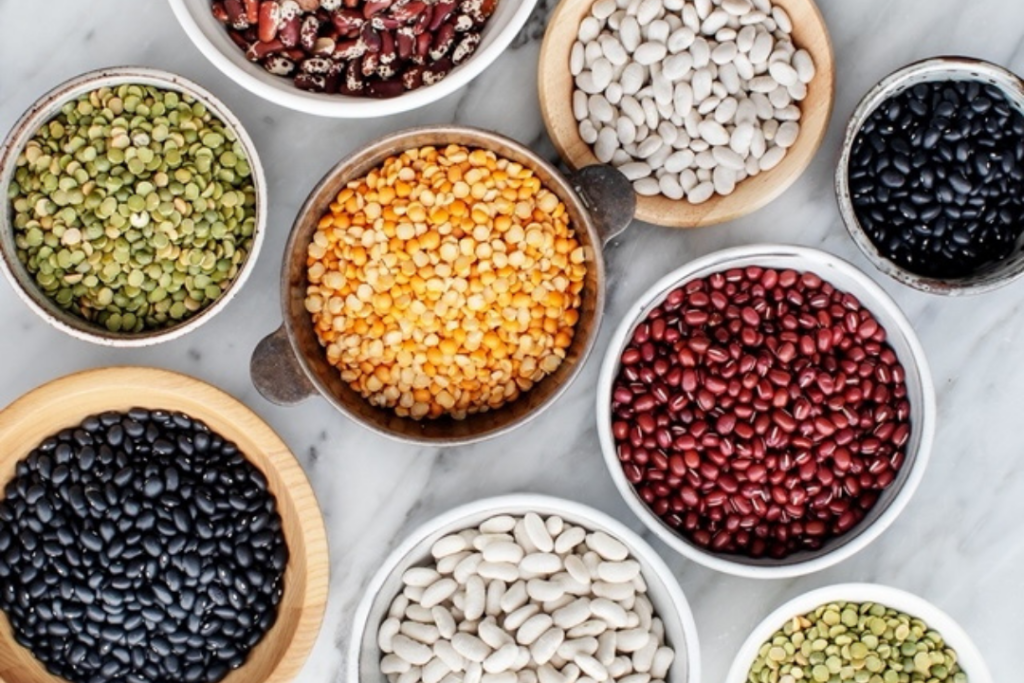
Beans are a wonderful way to add high-quality, plant-based protein to your diet. They’re super versatile and high in iron, B vitamins, and fiber. Dry beans stay fresh longer when stored in a cool, dark place (rather than on your countertop). Don’t use beans that are more than a year old, as their nutrient content and digestibility are much lower. Also, old beans will not soften, even with thorough cooking.
Follow these steps when preparing beans:
- Rinse beans and check beans for rocks or broken pieces.
- Cover in water and soak for six hours or overnight. Small and medium-size beans may require less soaking – about four hours should be enough.
Note: If you’ve forgotten to presoak the beans, you can bring them to a boil, turn off the heat, cover the pot and let soak for one hour.
- Drain and rinse the beans, discarding the soaking water. Always discard any loose skins before cooking, as this will increase digestibility.
- Place the beans in a heavy pot and add 3 to 4 cups fresh water.
- Bring to a full boil and skim off the foam.
- Add a small piece of kombu (seaweed) and a few bay leaves or garlic cloves for flavor and increased digestibility.
- Cover, lower the temperature and simmer for the suggested time. Check beans 30 minutes before the minimum cooking time. Beans are done when the middle is soft and easy to squeeze.
- About 10 minutes before the end of cooking time, add 1 teaspoon of unrefined sea salt.
- Cook until beans are tender.
GET EVEN HEALTHIER!
Are you curious about how to harmonize your health goals? How to fit wellness into your busy schedule? Let’s talk! Schedule an initial complimentary consultation with me today—or pass this offer on to someone you care about!
Versión En Español
Los frijoles son una manera maravillosa de agregar proteínas de alta calidad a su dieta. Son súper versátiles y ricos en hierro, vitaminas B y fibra. Los frijoles secos se mantienen frescos por más tiempo cuando se almacenan en un lugar fresco y oscuro (no encima del “counter”). No use frijoles que tengan más de un año, ya que su contenido de nutrientes y su digestibilidad son mucho más bajos. Además, los frijoles viejos no se ablandarán, aunque que cocinen por largo tiempo.
Siga estos pasos al preparar frijoles:
- Enjuague los frijoles y revise que no tengan piedras ni pedazos duros.
- Cúbralo con agua y déjelo en remojo durante seis horas o toda la noche. Los frijoles pequeños y medianos pueden requerir menos remojo; unas cuatro horas deberían ser suficientes.
Nota: Si olvidó remojar los frijoles, puede llevarlos a ebullición, apagar el fuego, tapar la olla y dejar en remojo durante una hora.
- Escurre y enjuaga los frijoles, desechando el agua de remojo. Deseche siempre las pieles sueltas antes de cocinar, ya que esto aumentará la digestibilidad.
- Coloque los frijoles en una olla pesada y agregue de 3 a 4 tazas de agua fresca.
- Llevar a ebullición y quitar la espuma.
- Agregue un pequeño trozo de kombu (algas marinas) y algunas hojas de laurel o dientes de ajo para darle sabor y aumentar la digestibilidad.
- Tape, baje la temperatura y cocine a fuego lento durante el tiempo sugerido. Revise los frijoles 30 minutos antes del tiempo mínimo de cocción. Los frijoles estarán listos cuando el medio esté suave y fácil de exprimir.
- Aproximadamente 10 minutos antes del final del tiempo de cocción, agregue 1 cucharadita de sal marina sin refinar.
- Cocine hasta que los frijoles estén tiernos.
